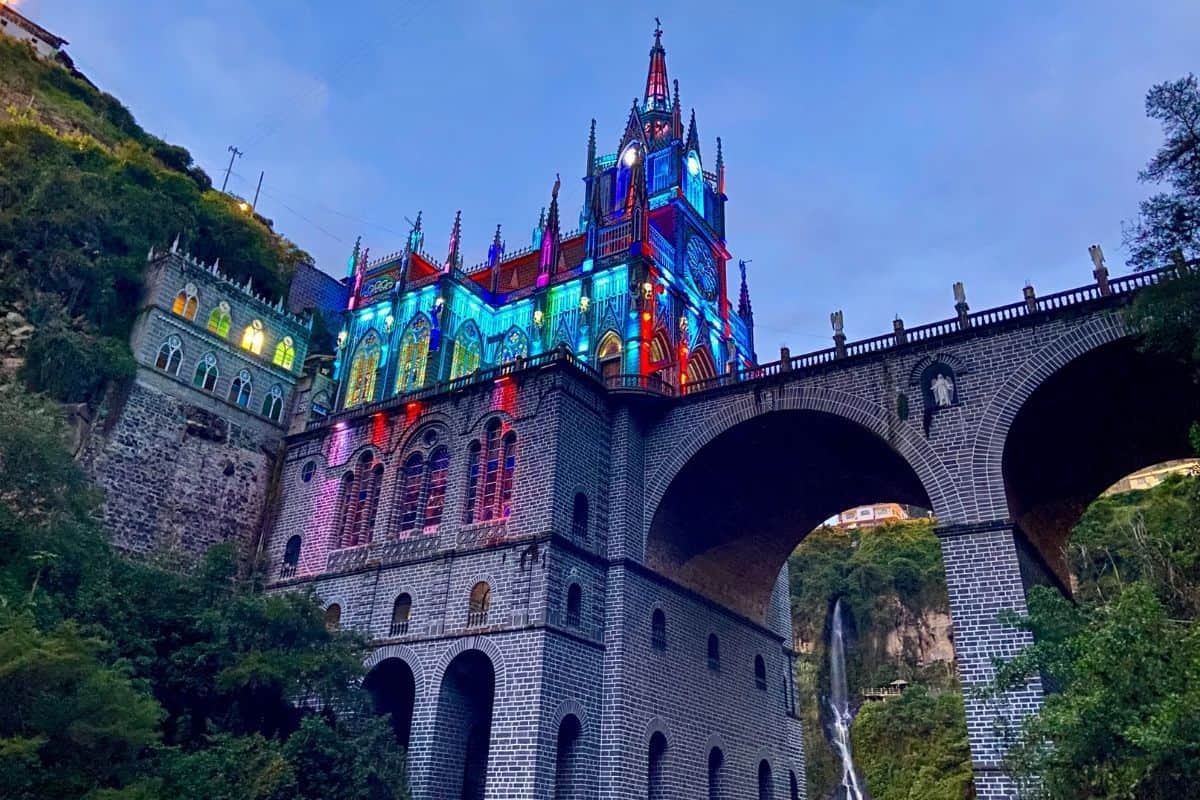Las Lajas Sanctuary Facts - History & Architecture
Are you looking for Las Lajas Sanctuary facts? Want to know about its history and architecture? Maybe you’d like to separate the facts from the fiction surrounding this beautiful site in Ipiales, Colombia?
If so, you’ve come to the right place! In this article, we’re going to do just that. So read on for many interesting Las Lajas Sanctuary facts!
If you’re planning to visit the Las Lajas Sanctuary and want travel info, check out our Las Lajas Sanctuary Colombia ULTIMATE travel guide.
Table of Contents
✧Las Lajas Sanctuary Facts - The History
✧Our Lady of Las Lajas Debunked - Just the Facts
✧Who Built Las Lajas Sanctuary, Colombia?
✧Las Lajas Sanctuary Architecture
✧Conclusion
Las Lajas Sanctuary Facts - The History
⚠️ Note: as with many legends, there are often many differing versions of the story. In the following sections, I’ve shared the most commonly cited details of this legend.
The legend goes back to the mid-18th century and involves an indigenous woman named María Mueses de Quiñones. Popularly known as “La Juana,” she was a descendant of the chiefs of the nearby town of Potosí.
One day in 1754, María was walking alone along the the river canyon when a violent storm caught her by surprise. So she took refuge in a cave near the riverbank. Frightened by tales of the devil appearing in that area, she prayed to the Virgin of the Rosary for help.
At that moment, says the legend, she felt someone touch her on the back. Fearfully, she turned around and saw nothing, but her fright was so overwhelming that she rushed out of the cave.
The First Miracle and Apparitions
Some days later, María returned to the site from the nearby town of Ipiales. On her back, she carried her young daughter Rosa, who was born deaf and mute.
When she arrived at the cave, she sat down to rest. After some time, Rosa shocked her as she spoke for the very first time in her young life. “Mommy, look at that mestiza who’s fallen down with her child in her arms and two other mestizos by her side.”
But María didn’t see anything.
After leaving the cave, María and her daughter Rosa walked to Ipiales. There, María told some of the townspeople about what had just happened. They didn’t believe her, so she began to walk back to her house in Potosí.
Along the way, she passed near the same cave, where Rosa once again spoke. This time she shouted, “Mommy, the mestiza is calling me!” but the still-shocked María continued with her daughter back to Potosí.
Once at the house, María was reflecting on everything that had happened, when she realized that Rosa had disappeared. Anxiously searching for her, something told María to go back to the cave. It was there that she found Rosa, but she wasn’t alone.
The legend goes on to say that Rosa was on her knees at the feet of the mestiza, the Virgin Mary, and she was playing happily with the mestiza‘s young son, the child Christ.
The Second Miracle
As you might expect, this supernatural encounter went unnoticed because nobody believed María when she told them about it. However, that all changed after the occurrence of a miraculous event, around which this legend is based.
One day, María’s daughter Rosa tragically died. A distraught María carried her lifeless body to the Virgin Mary in the cave, pleading for her to resuscitate her daughter. So strong was her faith that the mestiza answered her prayers and revived Rosa (or so the story goes).
This time, the people of Ipiales had no choice but to believe María, and they organized a great pilgrimage to the cave outside of town on September 16th, 1754.
Upon arrival, they were overjoyed to see the image of the Virgin of Las Lajas painted on the stone, with the child Christ in her arms and Saint Francis and Saint Dominic at her side. It was the same image which we can see today.
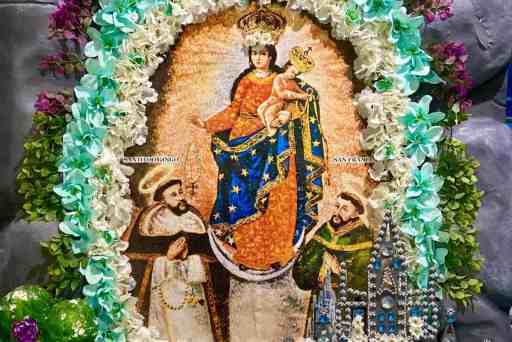
Shortly after, a simple shrine was built to house the image. Over the centuries, bigger and bigger temples were built in the same spot, culminating in the beautiful temple we see today. (More about that later.)
Since the appearance of the image, the locals have attributed healing properties to the water in the canyon around the church, and there have been reports of sick people being miraculously healed.
As a result, the church has become a famous and sacred site for Catholics who make pilgrimages there, visiting from just about every country.
Sources (in Spanish):
laslajas.org
santuariolavirgendelaslajas.com
Our Lady of Las Lajas Debunked - Just the Facts
When talking about Las Lajas Sanctuary facts, it’s important to separate the facts from the fiction. In this section, I’ll be focusing purely on the claim that is theoretically provable or disprovable: the famous image on the rock wall.
As for the apparition of Our Lady of Las Lajas, much like some other well-known claims of Marian apparitions such as Our Lady of Guadalupe and Our Lady of Lourdes, it happened so long ago that it would be impossible to prove or disprove.
You can’t exactly dust the scene for fingerprints.
The same is true of the claims of miraculous healings in the waters. A few allegedly happened in the somewhat distant past. If there have been more recent claims, they’re usually a lot of hearsay.
In fact, no evidence exists that has proven claims of faith healings or other “medical miracles” at Las Lajas or elsewhere.
But I’m not here to dissuade anyone from belief in the above phenomena. If you have faith in Marian apparitions and miraculous healing, far be it from me to argue with you.
The Myth of the Our Lady of Las Lajas Image
What I do want to discuss is the famous Our Lady of Las Lajas image on the rock wall for which the whole shrine exists. There are numerous writings in books and on websites about supposed Las Lajas Sanctuary facts that repeat the same unsubstantiated grandiose claims about it.
They say that it was not painted on the rock, but rather spontaneously appeared there. Not only that, but they say it was formed by the natural coloration of the rock and even extends several feet into the rock itself.
If such a claim were true, it would be easy to verify. Geologists could drill into the surface of the rock and take samples.
Well, say these sources, they’ve done that already! The Las Lajas image continues to baffle scientists! It’s clear that this is no painting.
The Burden of Proof
Here’s the problem with that: there’s no record of any scientific studies having been done on the rock.
These websites merely repeat the same claims, including that German scientists have studied it or that multiple scientists from twelve different countries have all tried, and failed, to debunk the image.
Of course, not a single source that I’ve found has cited a specific study nor indeed the name of even one scientist who has supposedly conducted one. If so many studies have been done, I would expect to find at least one published in a peer-reviewed journal. But I’ve found nothing.
Furthermore, there is no apparent evidence on or around the image that would indicate that studies have been carried out. There are no holes in the rock. How on Earth would somebody verify the claim that the image extends several feet into the rock without drilling into it?
And finally, there’s the curious fact that the image happens to be in the local art style of the time, known today as Spanish Colonial art (thanks to reddit user Anonymous-USA for informing me of that). If you compare it to images of Spanish Colonial art, it looks strikingly similar.
Even the official documentary which plays in the museum beneath the sanctuary points out that the painting looks a lot like 18th-century art from Quito, Ecuador.
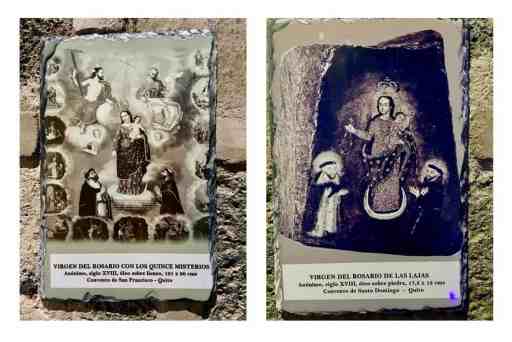
I’ll let you form your own opinion, though personally, my money’s on “painting, not miracle.” Even if that’s the case, it doesn’t completely rob us of the fun of mystery and intrigue. There would still be the question of who was responsible for the artwork.
No one knows the answer to that question, but we do know the answer to a related one:
Who Built Las Lajas Sanctuary, Colombia?
The construction of Las Lajas Sanctuary was the combined effort of many different people, both Colombian and Ecuadorian, including inexperienced and untrained townspeople and indigenous people.
Unfortunately, many lost their lives doing the dangerous work high above a rocky river canyon.
The entire project took place over a period of almost two hundred years and can be divided into five different stages. In each stage after the first one, a new building was constructed over the previous one.
The First Stage
In 1754, Friar Gabriel Villafuerte constructed a shrine to house the newly discovered image. It was a small hut of wood and straw.
The Second Stage
The second stage began in 1769. Fray Luis Herrero granted permission to blind Ipiales resident Manuel “El Ciego” Rivera to go from town to town in Colombia and Ecuador.
There, he would collect donations to buy materials for the construction of a new chapel to replace the old shrine.
On January 1st, 1795, quarry workers began preparing the stones for use in the construction of the chapel. Construction went on in full force, overseen by the Ecuadorian priest Eusebio Mejía y Navarro, at the beginning of 1796.
The process took seven years and resulted in a domed structure of stone and lime, measuring 7 meters long by 6 meters wide (approximately 23 feet by 20 feet).
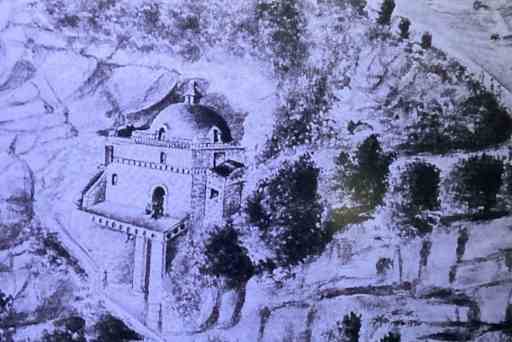
(Note: some sources, even a monument at Las Lajas Sanctuary, incorrectly cite the starting date of construction as 1765 or 1769. However, documents of the life of Eusebio Mejía y Navarro prove that impossible, as he would have been a child at that time.)
The Third Stage
The previous building proved too small to accommodate the masses of pilgrims who frequented the site.
So throughout the second half of the 1800s, Father José María Burbano y Lara undertook the widening of the building. They worked under the direction of the Ecuadorian architects Mariano Aulestia and Simón Atapuma.
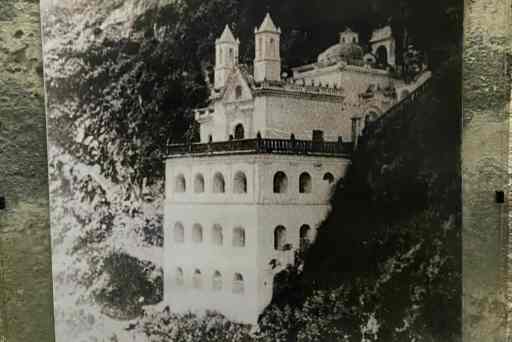
Additionally, a priest named Henry Collins ordered the drilling of a tunnel into the canyon wall in order to create the beautiful, artificial waterfall that is part of the allure of the site today.
The Fourth Stage
The next step was to connect the church to the opposite side of the canyon via a bridge that would also serve as a plaza as well as the church’s atrium. This idea gave birth to the fifth and final stage:
The Fifth Stage
This was the construction of the current sanctuary building. The idea to construct this new temple belonged to Ezequiel Moreno Díaz, the bishop of Pasto, Colombia. He wanted a larger, more modern building that could accommodate the increasing number of visiting pilgrims.
On September 15th, 1899, the first stone of the projected temple was laid and blessed. However, the plans failed due to the lack of expertise of the construction workers at the time.
Later, Bishop Moreno’s successor, a Spaniard by the name of Leonidas Medina Lozano, hired the Ecuadorian architect Gualberto Pérez to design the bridge and the new temple, and on January 1st, 1916, the “first second” stone was laid and blessed.
The project was undertaken by Gualberto Pérez along with the architects Lucindo Espinosa and Julián Espinosa González, as well as the chaplains José María Cabrera, Angel María Chamorro, Juan Bautista Pérez, and Alfonso Romo.
The plan suffered yet another setback as the first attempted construction of the bridge collapsed and fell into the canyon. This loss of materials and money stopped the project for several years.
Eventually, construction continued, and the project was finally completed on August 20th, 1949, under the direction of Justino Castulo Mejía y Mejía—a beautiful neo-Gothic structure with jagged spires and huge stained glass windows that absolutely must be seen in person.
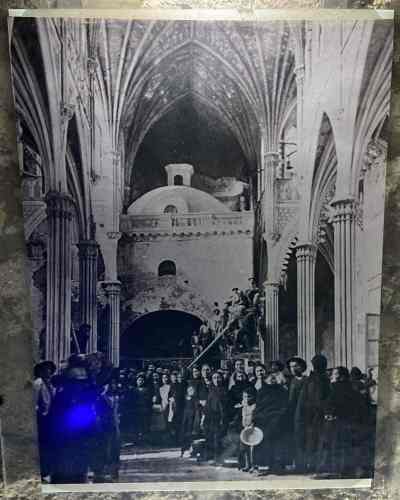
Sources:
laslajas.org (in Spanish)
El Santuario de la Virgen de Las Lajas - Pagina Oficial (in Spanish)
Wikipedia (in Spanish)
Wikipedia (in English)
Colombian Ministry of Culture (in Spanish)
Comprar en Ipiales (in Spanish)
Las Lajas Sanctuary Facts - The Architecture
The current building is a gray and white stone basilica church (not a cathedral, as it is often erroneously called). It was constructed between 1916 and 1949 in a Gothic Revival, or neo-Gothic, style, imitating the 14th-century Gothic.
The basic design of the building is the traditional basilica form, a rectangular hall composed of three naves (vaulted ceilings shaped like an inverted ship). The central nave is taller than the lateral ones.
The building sits atop a bridge of two foundational arches that crosses the river. It functions as the church’s atrium or square in addition to joining the church to the other side of the canyon. It’s made of gray stone and bricks and is flanked by statues of angels playing musical instruments.
The height of the church, from its base at the bottom of the canyon to the top of its tallest tower, is 100 meters (330 feet). The bridge is 50 meters high, 17 meters wide, and 20 meters long (165′ by 56′ by 66′).
The main temple building is 27.5 meters long by 15 meters wide (90′ by 49′). It has three main towers (the tallest of which is a clock tower), numerous spires, pinnacles, buttresses, open arches, and stained glass rose windows.
Las Lajas Sanctuary Interior
The interior of the temple is white with gold trim. The ornate ceilings of the naves are ribbed vaults. Beautiful stained glass windows and rose windows, designed by prolific German artist Walter Wolf Wasserhouen, cast an otherworldly light inside the sanctuary.
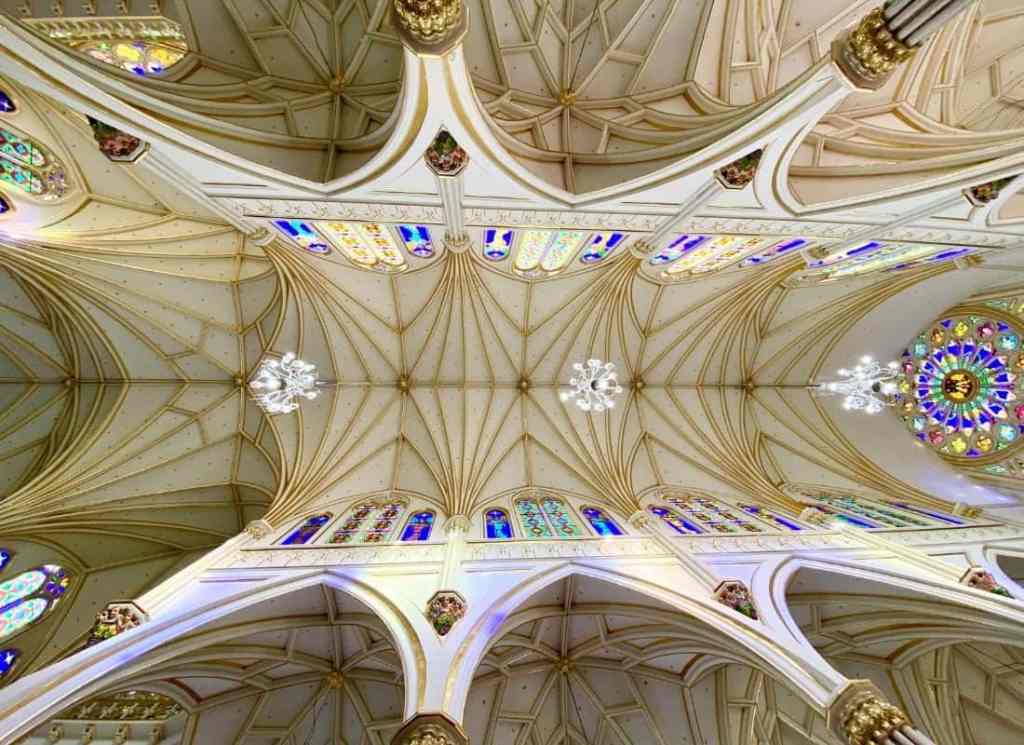

Opposite the front entrance, the rear wall behind the altar is the natural rock wall of the canyon itself. The centerpiece of that wall is the mysterious painting which the church was constructed to house.
Beneath the floor is the base of the temple. It, along with the arches of the bridge, is a crypt imitating the Romanesque style. It’s composed of three barrel-vaulted naves.
A “Shocking” Benefit
As mentioned, the foundations of both the sanctuary and the bridge are a great number of arches. Although that was a purely aesthetic decision, it had an unexpected benefit: it made the church earthquake proof.
With several volcanoes circling it, the area of Las Lajas is a hotbed of seismic activity. Yet the church has remained completely intact, despite the numerous earthquakes that have occurred there.
The reason, according to the church museum’s documentary, is that the arches disperse the seismic shockwaves. This prevents them from causing too much stress to the construction.
Conclusion
The Las Lajas Sanctuary in Ipiales, Colombia, has been named one of the world’s most beautiful churches. It’s easy to see why it’s such a popular tourist destination.
As such, it’s also the subject of much speculation and many myths. We hope that this article of Las Lajas Sanctuary facts has helped you separate fact from fiction.
We also hope it has inspired you to visit this beautiful place. Be sure to check out our ultimate travel guide to the Las Lajas Sanctuary Colombia.
📸 For more photos from our visit to Las Lajas and other sites in Colombia (and beyond), follow us on Instagram.

